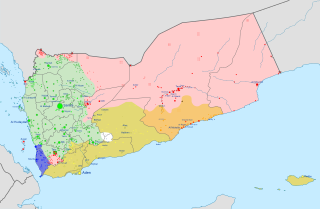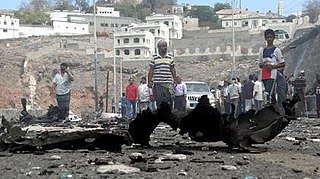In its war on terrorism in Yemen, the US government describes Yemen as "an important partner in the global war on terrorism". There have been attacks on civilian targets and tourists, and there was a cargo-plane bomb plot in 2010. Counter-terrorism operations have been conducted by the Yemeni police, the Yemeni military, and the United States Armed Forces.

Al-Qaeda in the Arabian Peninsula, abbreviated as AQAP, also known as Ansar al-Sharia in Yemen, is a Sunni Islamist insurgent extremist group, which is part of the al-Qaeda network and primarily active in Yemen and Saudi Arabia. It is considered the most active of al-Qaeda's branches that emerged after the weakening of central leadership.

The Al-Qaeda insurgency in Yemen is an ongoing armed conflict between the Yemeni government, the United States and their allies, and al-Qaeda-affiliated cells in Yemen. It is a part of the Global War on Terror.

The siege of Dammaj began in October 2011 when the Houthis, a Zaydi-led rebel group which controls the Sa'dah Governorate, accused Salafis loyal to the Yemeni government of smuggling weapons into their religious center in the town of Dammaj and demanded they hand over their weapons and military posts in the town. As the Salafis refused, Houthi rebels responded by imposing a siege on Dammaj, closing the main entrances leading to the town. The town was controlled by the Houthis and the fighting was mainly centered at Dar al-Hadith religious school, which was operated by Salafis.
The 2012 Sana'a bombing was a suicide attack on 21 May 2012, against Yemeni Army soldiers practicing for the annual Unity Day military parade in Sana'a, Yemen. The ceremony is carried out every year on 22 May since 1990 to mark the unification of North Yemen and South Yemen as the Republic of Yemen. Responsibility for the attack was claimed by the Al Qaeda in the Arabian Peninsula (AQAP) affiliate Ansar al-Sharia.

Jama'at Ansar al-Shari'a, also known as Ansar al-Shari'a, is a Yemen-based umbrella organization which includes units from several militant Islamic groups of al-Qaeda in the Arabian Peninsula (AQAP). In 2011, AQAP created Ansar Al-Sharia as a Yemen-based affiliate focused on waging an insurgency rather than international attacks on the West. In the view of the International Crisis Group, AQAP is "an internally diverse organisation with varying layers of support among the local population" and many AAS members and allies are not committed to AQAP's international agenda.

United States drone strikes in Yemen started after the September 11, 2001 attacks in the United States, when the US militant attacked Islamist military presence in Yemen, in particular Al-Qaeda in the Arabian Peninsula using drone warfare.

The following lists events that happened in 2015 in Yemen.
"Yemeni Crisis (2011–present)" refers to events of the Houthi insurgency in Yemen, the Yemeni Revolution, the Al-Qaeda insurgency in Yemen and the South Yemen insurgency.

The aftermath of the Houthi takeover in Yemen refers to developments following the Houthis' takeover of the Yemeni capital of Sana'a and dissolution of the government, which eventually led to a civil war and the Saudi Arabian-led intervention in Yemen.

The Yemeni civil war is an ongoing multilateral civil war that began in late 2014 mainly between the Rashad al-Alimi-led Presidential Leadership Council and the Mahdi al-Mashat-led Supreme Political Council, along with their supporters and allies. Both claim to constitute the official government of Yemen.

On 26 March 2015, Saudi Arabia, leading a coalition of nine countries from West Asia and North Africa, launched an intervention in Yemen following a new joint request from Yemeni president Abdrabbuh Mansur Hadi for military support after his forces were ousted from Sanaʽa by Houthi insurgents during the Yemeni Civil War. Government forces, Houthi rebels, and other armed groups fought after the draft constitution and power-sharing arrangements collapsed, despite progress made by the UN during the political transition at that time. Violence escalated in mid-2014. Houthis and allied insurgents seized control of Sana'a in September 2014 and thereafter. In response, President Hadi asked Saudi Arabia to intervene against the Iranian-backed Houthis.

The Aden unrest was a conflict between Islamist factions, such as al-Qaeda in the Arabian Peninsula, and Islamic State of Iraq and the Levant's Yemen Branch, against the loyalists of president Abd Rabbuh Mansur Hadi and later to conflict between UAE-backed and Saudi-backed factions within the coalition. In 2017, fighting also broke out between factions aligned with different members of the Saudi-led coalition namely Saudi Arabia-backed Abdrabbuh Mansur Hadi and Al-Islah and UAE-backed separatist Southern Transitional Council and Southern Movement.

The Islamic State – Yemen Province is a branch of the militant Islamist group Islamic State (IS), active in Yemen. IS announced the group's formation on 13 November 2014.
On 15 May 2016, a suicide bombing in the southern Yemeni port city of Mukalla, the capital of the Hadhramaut province, killed at least 47 police and injured over 60. The bombing was preceded by an attack, where 15 Yemeni troops were killed in attacks on army positions outside Mukalla. ISIL said, one of its militants blew up a vehicle, packed with explosives, in an army base in the Khalf district at the city's eastern outskirts.
The following lists events that will happen in 2016 in Yemen.
The following is a timeline of the Yemeni civil war, which began in September 2014.
The Hadramaut insurgency was an insurgency in Yemen launched by AQAP and ISIL-YP against forces loyal to president Abdrabbuh Mansur Hadi.

The January2021 Baghdad bombings were a pair of terrorist attacks that occurred on 21 January 2021, carried out by two suicide bombers at an open-air market in central Baghdad, Iraq. They killed at least 32 people and injured another 110. This was the Iraqi capital’s first terrorist attack since 2019.
On 24 September 2015, a double suicide bombing was carried out by Islamic State at a mosque in Sanaa, Yemen, killing at least 25 people.









